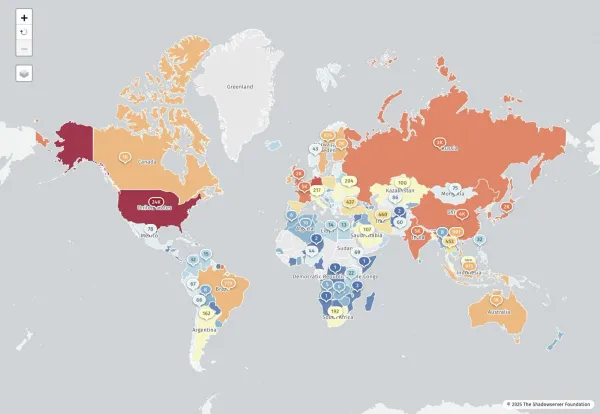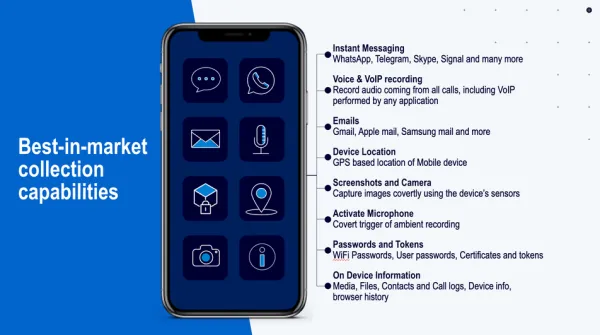Game-Changer for Breach Response: New Tool Instantly Maps Sensitive Data Across All 19 U.S. State Privacy Laws
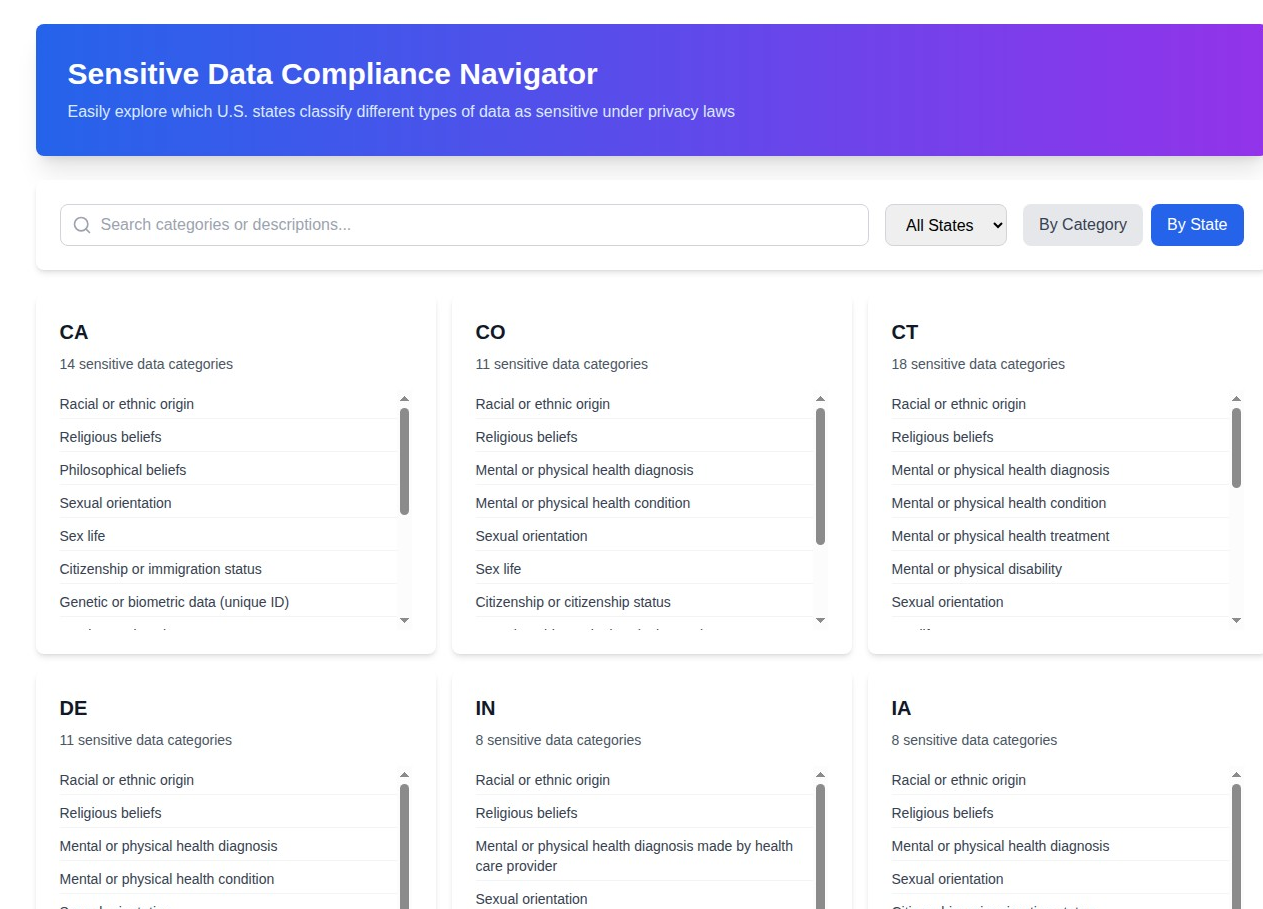
When a data breach hits, every second counts—especially when determining notification requirements across multiple states. A powerful new free tool is revolutionizing how incident response teams assess sensitive data exposure across the complex patchwork of U.S. state privacy laws.
The Breach Response Nightmare: State-by-State Compliance Chaos
Picture this: Your organization just discovered a data breach affecting users across multiple states. As the incident response team scrambles to contain the damage, a critical question emerges: Which types of data in this breach are considered "sensitive" under each state's privacy laws?
Until now, answering this question meant manually cross-referencing 19 different state privacy laws, each with unique definitions and requirements. California treats inferences differently than Colorado. New Hampshire has specific carve-outs for financial data. Connecticut includes neural data protections that other states don't even recognize.
For breach response teams, this complexity translates to:
- Delayed notifications while legal teams research state-specific requirements
- Over-broad notifications that unnecessarily alarm customers
- Compliance gaps that expose organizations to regulatory penalties
- Resource drain from manual legal research during critical response windows
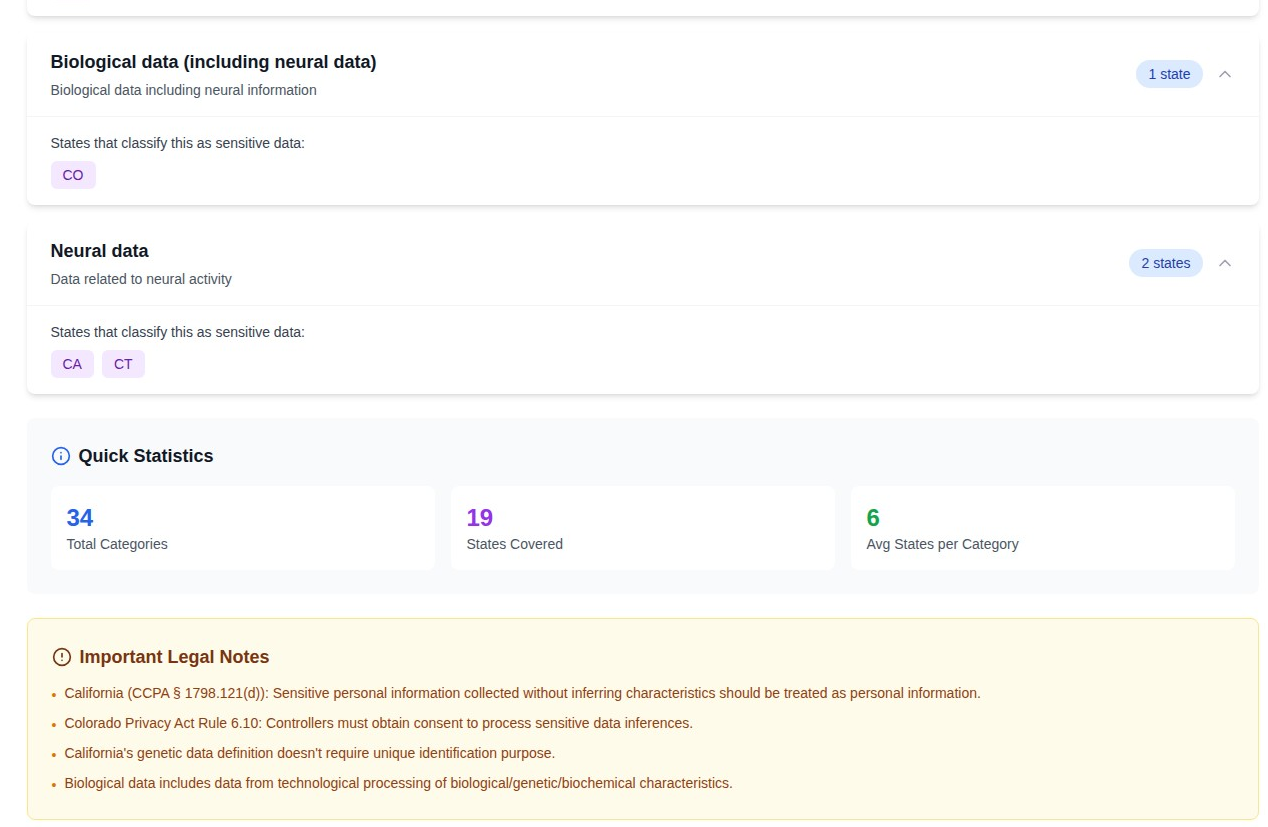
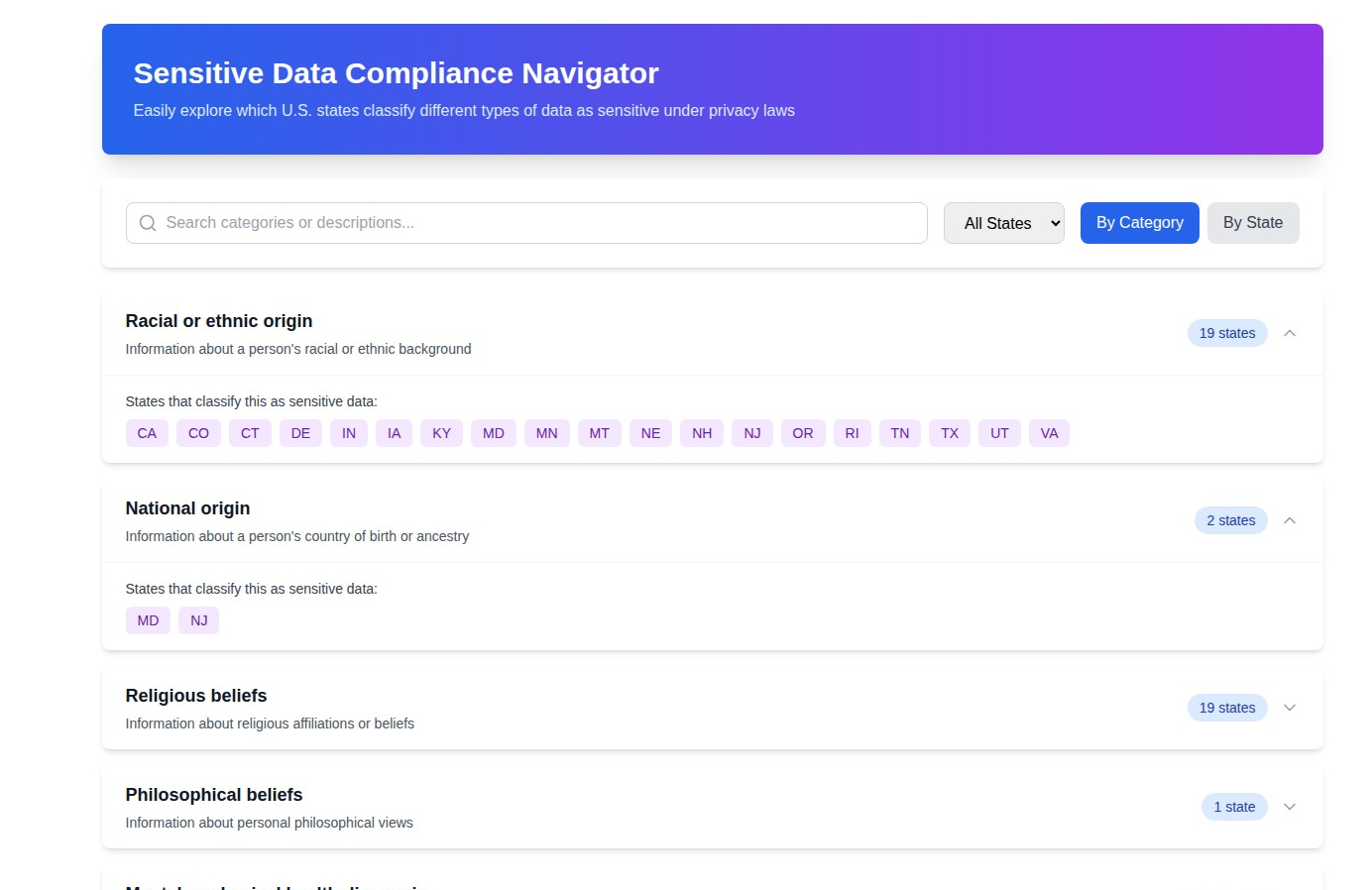
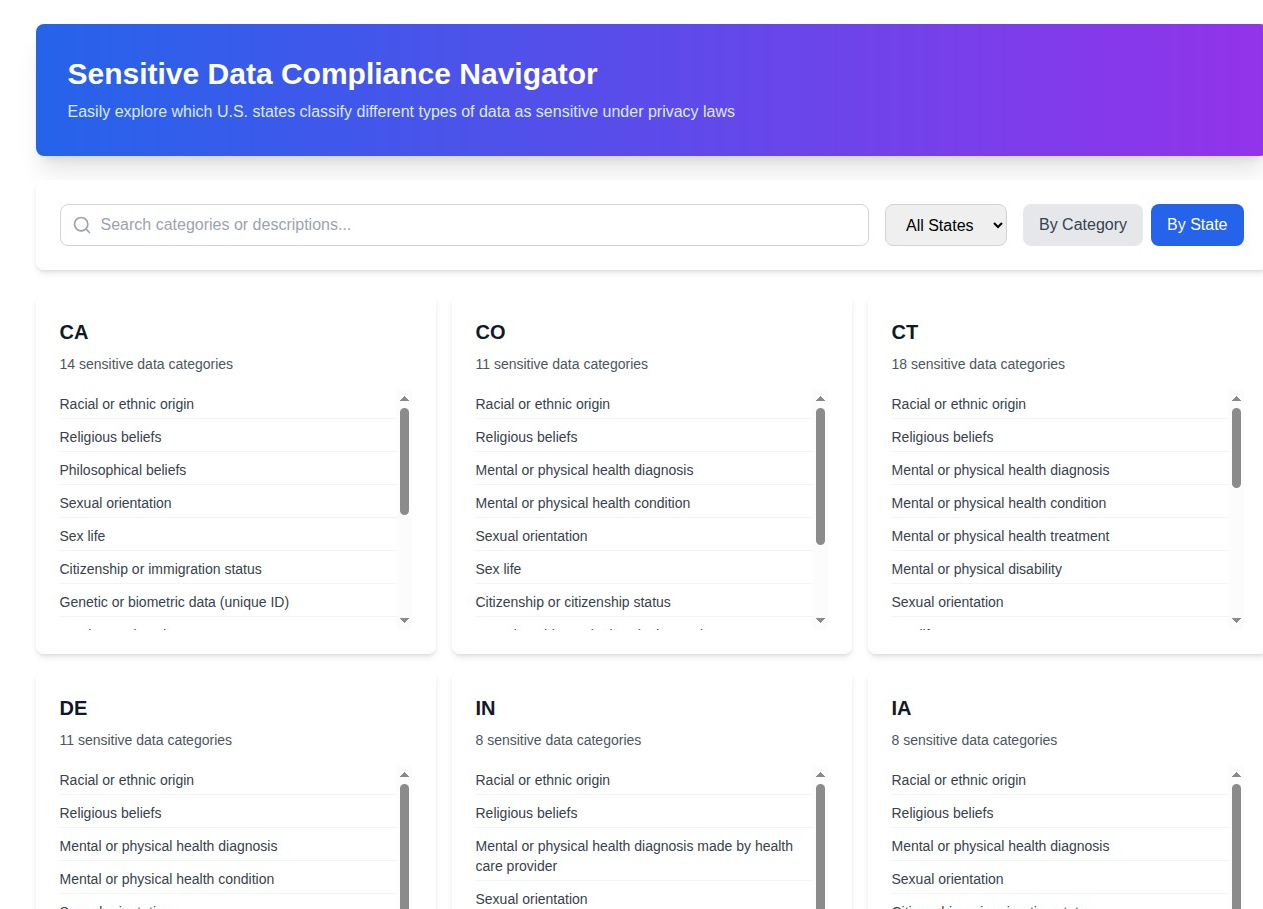
Enter the Sensitive Data Compliance Navigator
The Sensitive Data Compliance Navigator transforms this chaotic landscape into an intuitive, searchable interface that incident response teams can actually use in real-time.
What Makes This Tool Essential for Breach Response
Comprehensive State Coverage: All 19 states with comprehensive privacy laws are mapped against 34 distinct sensitive data categories—from the obvious (SSNs, health records) to the emerging (neural data, biometric identifiers).
Instant Impact Assessment: When a breach occurs, teams can immediately search for specific data types to see which states consider them sensitive. Search "financial account" and instantly see that 15 states have specific protections, each with slightly different requirements.
Dual Navigation for Different Use Cases:
- By Category: "We've had a breach involving biometric data—which states consider this sensitive?"
- By State: "We need to notify California residents—what data categories require enhanced protection?"
Visual Compliance Mapping: Color-coded indicators show at a glance which states have the most restrictive requirements, helping prioritize notification strategies.
Real-World Breach Scenarios
Scenario 1: Healthcare Data Breach A healthcare SaaS provider discovers unauthorized access to patient records. Using the Navigator, the incident response team instantly identifies that while all 19 states protect health diagnoses, only 12 states specifically classify "health treatment information" as sensitive—crucial for scoping notification requirements.
Scenario 2: Financial Services Incident A fintech company experiences a database exposure. The Navigator reveals that while most states protect financial account numbers, California, New Hampshire, and Connecticut each have unique additional requirements for financial data—potentially affecting breach notification scope and timeline.
Scenario 3: Employee Data Exposure An HR system breach exposes employee records across multiple states. The team uses the Navigator to quickly determine that union membership is considered sensitive in 18 states, sexual orientation in 19 states, but citizenship status protections vary significantly by jurisdiction.
Beyond Breach Response: Strategic Compliance Planning
While the Navigator shines during incident response, its value extends throughout the data lifecycle:
Data Classification Programs: Automatically flag data elements that require enhanced protection based on where your users are located.
Privacy Impact Assessments: Quickly evaluate whether new data collection or processing activities involve sensitive data categories across your operating jurisdictions.
Vendor Risk Management: Assess third-party data handling practices against state-specific sensitive data requirements.
Data Retention Policies: Ensure retention schedules account for enhanced protection requirements for sensitive data categories.
Key Insights from the Data
The Navigator's comprehensive analysis reveals important patterns that affect breach response planning:
- Universal Protections: Racial/ethnic origin and religious beliefs are protected across all 19 states—making these the highest-priority categories for immediate notification
- Health Data Complexity: States distinguish between diagnoses, conditions, treatments, and health insurance information—each potentially triggering different notification requirements
- Emerging Categories: Colorado's biological data protections and California's neural data classifications signal where privacy law is heading
Critical Considerations for Incident Response Teams
While the Navigator dramatically simplifies compliance research, remember:
Legal Nuances Matter: Some states have specific conditions and exceptions that may affect breach notification requirements. Always consult legal counsel for final notification decisions.
Evolving Landscape: Privacy laws continue to evolve. The Navigator is regularly updated, but verify current requirements for active incidents.
Professional Guidance: This tool enhances but doesn't replace experienced privacy counsel, especially for complex breach scenarios.
The Bottom Line
In the high-stakes world of data breach response, the Sensitive Data Compliance Navigator eliminates a major source of delay and confusion. Instead of burning precious hours researching state-specific requirements, incident response teams can instantly understand their compliance landscape and focus on what matters most: protecting affected individuals and meeting regulatory obligations.
For organizations operating across multiple states, this free tool isn't just helpful—it's essential infrastructure for modern breach response.
Access the Sensitive Data Compliance Navigator and transform your approach to multi-state privacy compliance.
Have you used the Navigator for breach response or compliance planning? Share your experience and help the community learn from real-world applications of this powerful tool.




